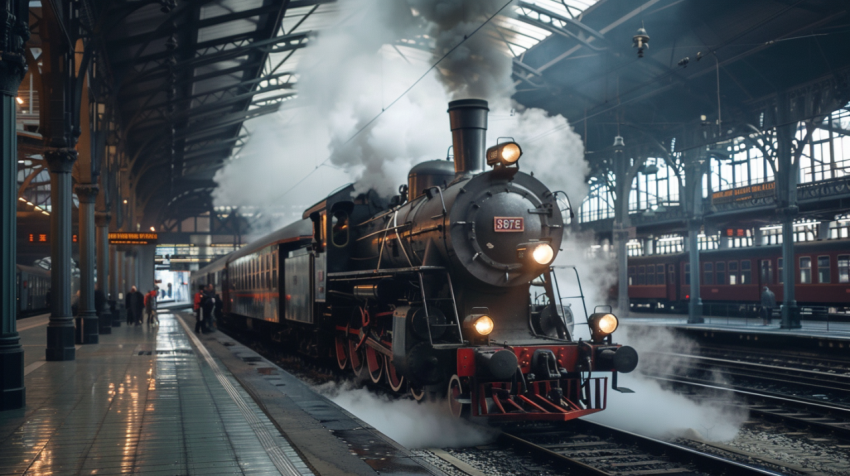











A Comprehensive Guide to Train Propulsion: Powering the Railways
The power and propulsion systems of trains have undergone a dramatic evolution since the first steam locomotives chugged across the landscape. From the raw power of steam to the cutting-edge technology of magnetic levitation, each advancement in train propulsion has brought increased speed, efficiency, and environmental benefits. This exploration delves into the major types of train power and propulsion, highlighting their mechanisms, advantages, and disadvantages.
1. Steam Locomotives: The Pioneers of Rail
Steam locomotives were the driving force behind the early development of railways. They operate on the principle of using steam power to generate motion.
- Mechanism: Coal (or sometimes wood or oil) is burned in a firebox to heat water in a boiler, creating steam. This high-pressure steam is then used to push pistons connected to the driving wheels, propelling the train forward.
- Advantages: Steam locomotives were instrumental in the Industrial Revolution, enabling the transportation of goods and people on an unprecedented scale. They are relatively simple in design and can be built with readily available materials.
- Disadvantages: Steam locomotives are inefficient, requiring large amounts of fuel and water. They produce significant pollution and are labor-intensive to operate and maintain. They have mostly been replaced by cleaner and more efficient technologies.
2. Diesel Locomotives: The Workhorses of Modern Rail
Diesel locomotives replaced steam as the dominant form of train propulsion in the mid-20th century. There are two primary types:
- Diesel-Mechanical: These locomotives use a diesel engine to power a mechanical transmission, similar to a car or truck. They are typically used for low-power applications, such as shunting (switching) and light freight.
- Diesel-Electric: These are the most common type of diesel locomotive. The diesel engine drives an electrical generator, which in turn powers electric traction motors that turn the wheels.
- Mechanism: The diesel engine turns a generator that produces electricity. This electricity powers traction motors mounted on the axles, which provide the force to move the train.
- Advantages: Diesel-electric locomotives are more efficient than steam locomotives, require less maintenance, and offer better control and tractive effort.
- Disadvantages: They still produce emissions, although modern diesel engines are significantly cleaner than older models. They rely on fossil fuels, contributing to environmental concerns.
3. Electric Locomotives: The Clean and Efficient Choice
Electric locomotives draw power from an external source, typically overhead lines or a third rail.
- Mechanism: Electric current is collected from the power source through a pantograph (for overhead lines) or a shoe (for a third rail). This electricity powers traction motors that drive the wheels.
- Advantages: Electric locomotives are highly efficient, produce zero emissions at the point of use, and offer excellent acceleration and performance. They are quieter and require less maintenance than diesel locomotives.
- Disadvantages: They require significant infrastructure investment in electrification. Their operation is limited to electrified routes. Regenerative braking in some allows to put energy back into the system when slowing.
4. Gas Turbine-Electric Locomotives: These locomotives used a gas turbine to generate electricity which, in turn, powered electric motors connected to the wheels.
- Mechanism: Similar to how a jet engine works, but instead of producing thrust, the turbine's power is used to generate electricity.
- Advantages: High power-to-weight ratio, meaning they could be powerful without being excessively heavy. Potentially lower maintenance compared to diesel engines due to fewer moving parts in a turbine.
- Disadvantages: Fuel efficiency was generally not as good as diesel engines, especially at lower speeds or when idling. They were quite noisy. Concerns about the cost and availability of suitable fuel. 5. Magnetic Levitation (Maglev): The Future of Rail?
Maglev trains represent a radical departure from traditional rail technology. They use magnetic forces to levitate above the track, eliminating friction and enabling extremely high speeds.
- Mechanism: Powerful electromagnets on the train and the track create a magnetic field that lifts the train and propels it forward. There are two main types of maglev technology:
- Electromagnetic Suspension (EMS): Uses attractive forces between electromagnets on the train and a ferromagnetic track.
- Electrodynamic Suspension (EDS): Uses repulsive forces between superconducting magnets on the train and conductive coils on the track.
- Advantages: Maglev trains are incredibly fast, with the potential to reach speeds exceeding 600 km/h (373 mph). They are also very smooth and quiet due to the lack of physical contact with the track. Energy efficiency at top speed is better than a conventional high speed rail.
- Disadvantages: Maglev systems are extremely expensive to build, requiring dedicated tracks and infrastructure. They are currently only in operation in a few locations worldwide.
Conclusion
The evolution of train power and propulsion has been a journey of continuous innovation, driven by the desire for greater speed, efficiency, and environmental responsibility. From the age of steam to the promise of maglev, each technology has played a crucial role in shaping the railways we know today. As we look to the future, the focus will likely be on further developing electric and other alternative propulsion systems to create a more sustainable and efficient rail network. Research into new materials, battery technology, and alternative fuels will continue to drive innovation in train propulsion, promising even faster, cleaner, and more efficient trains in the years to come. The ongoing development of these technologies holds the key to a future where rail travel is not only a practical mode of transportation but also a sustainable one, playing a vital role in a world increasingly focused on reducing its environmental impact.
train propulsion, train power, types of train engines, train engine technology, how do trains work, diesel electric locomotive, electric train, steam locomotive, maglev train, train engine, train motor, railway propulsion, bullet train technology, high speed rail technology, How does a diesel train work, How does an electric train work, How fast do maglev trains go, What is a third rail, What is a pantograph, how does a steam engine work, advantages of electric trains, disadvantages of diesel trains, how do maglev trains levitate, future of train technology, difference between diesel and electric locomotives, environmental impact of different train types, working principle of electric locomotive, gas turbine-electric locomotives, advantages and disadvantages of gas turbine-electric locomotives, are gas turbine-electric locomotives still in use, where are gas turbine-electric locomotives used, what happened to gas turbine-electric locomotives, history of gas turbine-electric locomotives, gas turbine-electric locomotives vs diesel

